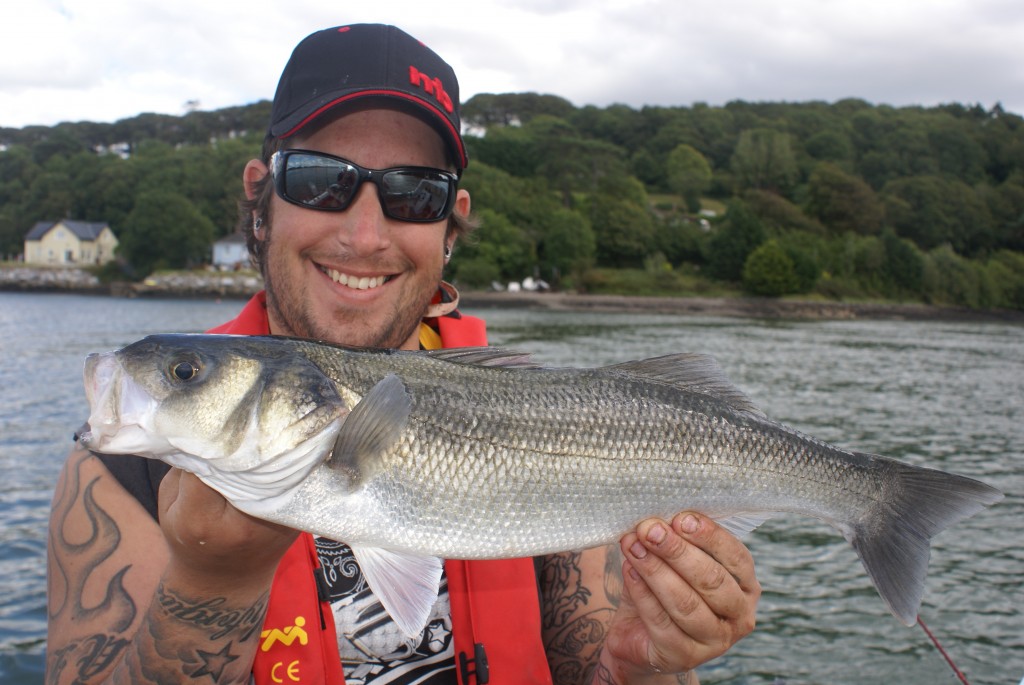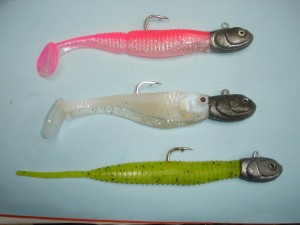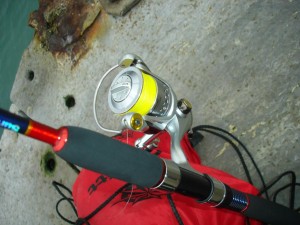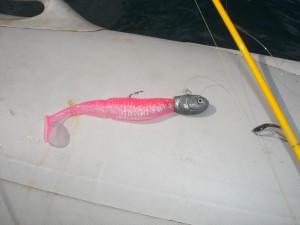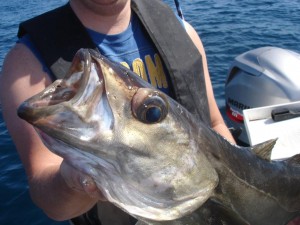Lure angling is the fastest growing and exciting branch of boat angling. While the idea is not new it is the availability of new gear that helps increase catches and multiplies the craic factor. Jim Clohessy goes back to the basics of lure angling.
Boat Lure Basics
(This article originally appeared in Irish Angler Magazine).
I can tell exactly how it happened. It was somewhat about bass but really it was about trying to inject some more craic into my angling. I had a welly full of wrecking. I was sick of species. I was bored with bait. Not that I was having an angling identity crisis, no not in the least. I still love the idea of fishing a sunken ship. I love the romanticism that goes with wreck fishing. I love the possibility of fishing where the chance of an absolute monster is more than a hope. There is nothing like anchoring the boat and getting to grips with the slimy or the toothy predators that abound on our reefs. But despite all that I yearned for more. The thought of catching more bass on lures was the initial driver. The quest to catch more species on lures and the enjoyment of the active hunting style of fishing excited me. There were rumours from the continent there were stories from the States – it was all about the lures!
I meet anglers on a regular basis. I have always been forthcoming with information and help when I can. I have never experienced the amount of enquiries from anglers around the country about what I am doing at the moment. The interest in the YouTube clips I have put up on line is impressive. More and more anglers are getting into modern lure fishing from the shore and it is a natural progression that they extend that interest to the boat. However exciting the trend of lure fishing is from the shore it is fairly mind blowing from the boat. So what do these anglers ask about? Guys ask how to get involved. They want to dip their toes into the water without investing a huge pile. If they like what they see and do then there is time enough to invest in some of the amazing tackle that makes up part of the modern lure fishing phenomenon. If regular readers are reckoning that we have been here before you could be forgiven however I think given the massive upsurge of interest in the lure field it is no harm to go through things again as the season takes a late lift off.
The Rods
If you say to yourself that the 10 foot spinning rod that you have in the shed will do fine for some experimental lure angling then you may as well give up now! Part of the beauty of modern lure angling is that the rods that have been designed for purpose that will let you fish all day long and will work the lure well and will allow the fish to express itself while all the time bringing a smile to your face and a quicker pace to your heartbeat. Modern rods are made from modern composite material and the advantages are that they can outperform and out cast anything that went before while being a relatively light and slim package that really does not look like it will last the pace. Soft lures are not new. Granted some of the material is now more durable and soft than previously available but essentially the lures are fairly similar to what went before. The thing is, back then we really didn’t have the rods to fish the lures properly. Now we have and the choice that is now available is incredible.
Does the size of your rod matter? That is a subject that gets plenty of debate. Guys that were used to the 10 foot rod can have difficulty sizing down – I had this difficulty myself at the start. It is not until you experience the modern short lure rod that you realise that performance is not an issue with modern shorter rods. From the outset, spurred on by what I was seeing from my French buddies, I opted for 7-8 foot rods. They are most practical from the boat as you can work them in more ways than a longer rod. Many guys hedge their bets and opt for the 8 foot alternative, especially guys that are fishing from the shore as well. But I must say that my 7 foot rods will cast as far as any that I have compared in the 8 foot league. Don’t be fooled by the 9’6″ brigade in the UK! Short is best.
So what of makes, models and price? A few years back you would have to import a rod blind from the catalogue, not an exciting prospect! But now we are spoilt for choice and most decent tackle shops will stock a few different types. I will deal only with rods that I have fished with. There are now even more makes and models than ever before but those that I have not tested I will not comment on. Price is always an important factor, especially if you are just wanting to “suck it and see” as regards lure fishing. In that case we talk about rods around the fifty Euro mark – The Surecatch Powerbraid Salty Spin 7’ is the best low price rod I have used. the can be hard to source now. I would say if you are going to buy something, save for the mid-range and then save high end. Get into the mid-ranges and you have great offerings from Penn, Shimano, and the French makes like Sakura. €150 will buy a lot of rod. Let’s not forget the HTO Nebulas are well worth a look too. But be careful with them. Majorcraft seem to have gotten over a poor reputation for breaking Skyroads and Truzers – I don’t think I’d be brave enough…. But many do!
A word of warning – the ratings on rods really is only a guide. One manufacturer’s 5-30g rod is totally different from others.
Once you get hooked-and most do- you will find yourself investing in a higher-end rod and again there are many to choose from.The Pezon Et Michel Gunki Hayashi is a classy bit of kit. As we get up the scale we have beauties like the Abu Garcia RockSweeper and the Illex Element Rider’s and NITROS these are the pinnacle of modern rods that I have tested and used regularly. Don’t forget the marketeers dream that is Tenryu!
A word of warning – the ratings on rods really is only a guide. One manufacturer’s 5-30g rod can be totally different from others. Really you should get to hold and feel the rod in the shop before you buy and if you can actually cast one in anger before you part with your money all the better.
The Reels and Lines
You can spend as much as you wish on a reel. It really is down to personal choice. I usually opt for mid-priced reels that I will not feel cheated if they last only a few seasons. There really are some cracking high quality reels out there that are competitively priced. Shimano always get good press. I find them and Daiwa to be a little precious for my minimum maintenance programme! I have bee loving the revamped Penns. really, from the Spinfisher to the Clash to the Slammer it is hard to get to the end of a Penn. You will find that for most work a 2000-3000 sized reel will be perfect. You will be fishing with braid so the smaller spooled reels are perfect. When it comes down to braid make sure you go for the thinnest line you can find. You will want braid close to 20lb breaking strain if you intend to do some vertical fishing. It’s more about the ability to pull through a snag while having the thinnest braid possible – a good 20lb 8-strand will do that. Currently I am using OWNER kizuna Broad PE braid. It’s my favourite until something else takes my eye. You’ll find any amount of opinion on which braid is the best out there.
The Lures
Obviously you can use hard plastic lures, plugs and poppers, and metals for inshore casting work. The real deal with this style fishing is using soft plastic lures. Shads or stick bait type soft lures generally mounted on a lead head or weedless are the order of the day. I have always contended that any soft plastic lure will catch fish on any given day, especially if the fish are present in numbers. The trick is to experiment with lures in order to find what is working best. Everybody has their favourite lures. I stick to lures that have fished well for me over time. Hard to believe that there has been a lot of change in the sift lure market in recent years. I think many of the big tackle houses got a bit fed up of being ripped-off and left the market. Illex do not have as big a range as they once had. The Nitro shad is a fine lure and the Nitro Shad Slim is a superb offshore lure. Many of the small home grown lure companies have started out by copying a proven lure. Some have evolved into experimenting with something they can call their own design.
Of course any discussion on sft lures would not be complete without the mention of the Black Minnow from Fiiish. The humble Black Minnow is often copied but seldom equalled. Fiiish have brought a ggood few new lures to market in recent years. The Crazy Sandeel and Black Eel have all proven to be good fish catchers. The Crazy Paddle tail is an evolvement better than the original.
You can see that the range is huge and again you will find your own favourites. The important thing here is to experiment with different types of lures and different rigging to find combinations that work for you in different situations.
I use various types of lead heads but my favourite is a homemade head The V” Shad Head from Bricoleurre. I started out making articulated heads. An articulated head allows you to choose the size and the pattern of hook that you want. As time has gone by I make more “standard” heads than articulated, the Black Minnow fill the need for articulated heads.
Making heads is a great pastime. It was a purchase out of necessity at the time as I could not get any source of lead heads locally. Making your own heads is somewhat satisfying. When you start out on the lure route you will lose plenty of heads and it hurts a little less knowing you have made them yourself.
The important thing here is to experiment with different types of lures and different rigging to find combinations that work for you in different situations.
The Quarry
Most boat anglers have tackled Pollack on redgills and shads. It is not until you get a decent Pollack at the end of something like a 7 foot 5-30g rod that you realise the strength and the sheer sport that can be gleaned from this underestimated fish. Pollack are the easiest of all the lure target species to catch though winking out that 12lb specimen fish is more difficult than you would imagine.
Tactics for pollack are simple: once your lure hits bottom give the lure some animation with a few jigs while reeling briskly maybe six or eight turns. Pause a few seconds and animate the lure again and wind in further. By the time you have done this three or four times you will either have a Pollack swinging off your line or you will drop back down and repeat the process. Keep an eye on your sounder as Pollack will show up very well on most decent sounders. Vary you retrieving tactics: touch bottom and briskly reel twenty or thirty turns before dropping back down again. I prefer to be active and to keep the lure moving swiftly rather than the slow movements of the “gilling” days.
Cod and other bottom dwellers such as ling or ballan wrasse require different tactics. This is where the game gets a bit different from what we are used to. To catch these species you need to be in contact with the bottom. If you are on the bottom there is a good chance you will lose your gear. Therefore using a twitching or jigging motion you can keep your lure off the bottom but practically on the bottom. This takes more concentration and discipline that you can imagine. Fishing vertically like this behind a drifting boat is a very productive method. Casting uptide of the drifting boat is another technique that will allow your lighter lead to get to the bottom. Before the drifting boat catches up on the lure you can give the lure plenty of animation. This technique is widely practiced in France and would be typically defined as fishing “finesse” style with very light heads.
Of course all the above is dealing with fishing vertically under the boat. Sometimes this is not feasible due to shallow depths or you may be targeting fish that are too close to the shore line to be drifted for. Bass and wrasse will often fall into this category. In this case you will drift along and will cast your lure. Plastics are generally fished close to the bottom regardless of how they are deployed. After casting it is best to feel the lure touch or count down until you know the lure is close but not touching down on the bottom. With a deft flick of the modern lure rod the soft plastic will dance along the bottom generally being irresistible to any bass or wrasse that are in the area. You must remember that there are times where anchoring may produce better results or allow you more fishing time in an area. You as anchoring the boat may be better you may find there are times where a soft plastic lure fished weightless will do the business better than any other presentation. You can see there is more to this game than chucking the odd lure about! It doesn’t end with wrasse, bass and pollack though, sea trout, gurnards, plaice, flounder, whiting, haddock mullet and more can all be targeted with lures. Of course there are many anglers targeting micro species with lures as well. Chasing blennies and gobies is not my style really but you cannot deny the dedication and the effort that these anglers bring to the sport.
Of course bait has its place. There are times where nothing will out fish bait and there are species that require the use of bait but there is nothing like the hit from a lure caught bass, the blistering run of a pollack connected to a light modern lure rod or the thump of a big cod that you can barely move off the bottom. Every angler I know that tries gets hooked…try it at your peril as it could explode your heart in your chest!

